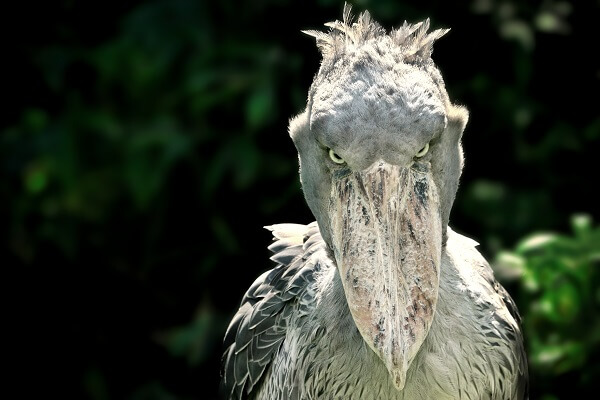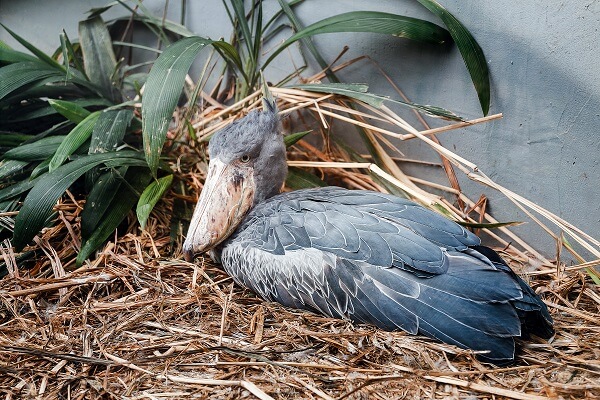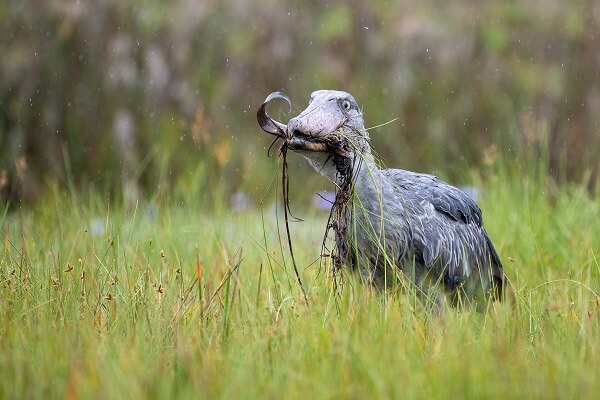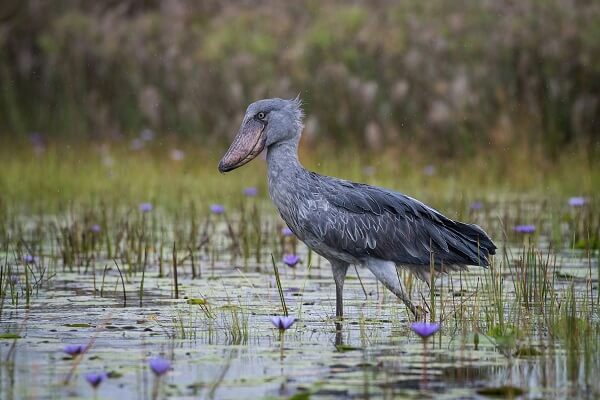
The shoebill stork (Balaeniceps rex) is a large, broad bird that is endemic to the swamps and wetlands of Central and East Africa. This giant bird has a large body, huge wings, and a bill that looks like a shoe. This prehistoric-looking bird is also believed to be related to the now-extinct dinosaurs! These birds have a dark grey, blue-grey, or slate-colored plumage with a white belly. Their piercing eyes are yellow or a white/grey mix. They have enormous wings that can span up to eight ft, which they use for soaring. This bird favors papaya swamps and is usually found in the overspill areas, where the water is flowing slowly towards a lake. This area is home to a lot of fish, which is the shoebill storks primary food source. Shoebill storks are diurnal, although they will occasionally hunt at night if the moonlight is bright enough. Aside from fish, they also prey on water snakes, frogs, monitor lizards, and young turtles. They have even been known to eat baby crocodiles! These birds are found in or near to water. They even build their nests on top of floating vegetation, using plant material from the surrounding area. Nests are usually located in the deeper parts of swamps, where the tall grass and dense vegetation provide cover from predators that may wish to eat their eggs. Shoebill storks reach sexual maturity at three to four years. They are monogamous birds that share parental responsibilities. The female will lay two to three eggs, and these incubate for 30 days. Both parents will turn the eggs frequently using their feet or their bills. Shoebill chicks are covered in a thick, silvery-grey down and already have a wide gape. However, the large bill that these birds are known for doesn’t begin to show until they are a month old. When they are born, the parents take turns feeding the chicks mashed up food. After they reach a month in age, the parents will start to leave prey items in the nest for the young birds to swallow. Fledging occurs at 95 days, and by 125 days, the chicks are independent. Humans have known about shoebill storks for a really long time. They were first described in writing that dates back as far as ancient Egypt. It is surprising then that we know relatively little about them compared to other species. However, what we do know demonstrates some amazing biological concepts! The shape of a bird’s beak is designed for eating particular types of food and offers a big clue as to what the primary source of food is. Shoebill birds have enormous bills that are shaped like a shoe and are an adaptation for catching and holding the large, slippery fish that it preys on. Its large bill ranges from 7.8 – 9.5 in (20 – 24 cm) long and 4 – 4.8 in (10 – 12 cm) wide. It also has a razor-sharp, curved hook at the end that is used to spear its prey. The size of their bill helps these birds to strike their prey in a unique technique known as a ‘collapse.’ The birds stand in the water motionless, looking for food. Once the birds have spotted their prey, they lunge or fall forward onto the prey with their wings spread. The bird then dives down, the bill first, and ambushes its prey. The shoebill bird then holds up its head and grinds the sharp edges of its bill together to decapitate its prey. At the same time, water and vegetation that was taken up at the same time as the prey item spill out from the edges of the bill. Shoebills, like pelicans and other storks, practice urohidrosis to keep cool. Urohidrosis is a cooling method, much like sweating, that enables the bird to cool down. Shoebill storks will defecate on their legs to lower their body temperature. The liquid waste that these birds excrete from there cloaca is a mixture of feces and urine. The waste covers the birds’ legs, and as it evaporates, it cools the birds’ skin, much like sweat evaporating cools down our skin. Unlike sweat, this method of cooling also involves a preventative measure. The evaporating liquid leaves behind a white, powdery substance that can reflect sunlight and prevent the legs from getting warm in the first place. How amazing is that! An animal’s primary goal is to survive and pass on their genes, and there are several examples of how animals do this in nature. The mechanisms that birds use can range from focusing their energy on a small clutch of eggs, or having a large brood to increase the probability of survival. Some birds are monogamous and work as a team to raise their chicks, while others are polygamous or promiscuous and prefer to mate with as many partners as possible. Once fascinating yet grim example of animal survival is that of siblicide. Siblicide is when one of the offspring kills its sibling. There are several examples of birds that practice this behavior, including egrets, herons, pelicans, boobies, and shoebill storks. Shoebill storks eggs hatch asynchronously. The first chick to hatch has no siblings to fight with over food, so it is well fed and develops quickly. When the second chick hatches, the parents do not make an effort to distribute food equally, and so it competes with its elder, well-developed sibling. The elder chick will bully and batter its sibling, and often the youngest chick will die due to its wounds or from starvation. By focusing on the strongest chick, the parents increase the chances of at least one of their offspring reaching maturity and passing on its genes. From a survival point of view, it is better to have one healthy chick than several that are weak and unlikely to survive. You may be wondering why the birds choose to lay more than one egg if only one chick is going to survive. The second and sometimes third egg is more like an insurance policy. If the first egg is infertile or lost to predation, the adults are still able to produce offspring. If food is plentiful, then there is limited aggression between the chicks, and it is more likely that all the chicks will fledge.
Kingdom
Animalia
Phylum
Chordata
Class
Aves
Order
Pelecaniformes
Family
Balaenicipitidae
Genus
Balaeniceps
Species
Balaeniceps rex
Niche
Terrestrial piscivores
Height
3.5 – 4.5 ft (110 to 140 cm)
Weight
Females 11 lbs (4.9 kg), Males 12lbs (5.6 kg)
Lifespan
35 years in wild, 50 years in captivity
Social Structure
Solitary, even when in mating pairs
Conservation Status
Vulnerable
Preferred Habitat
Swamps and wetlands
Average Clutch Size
2 – 3 eggs
Main Prey Species
Lungfish, catfish, and tilapia
Main Threats
Humans
The Basics

Interesting Insights from the Shoebill Stork!
Shoe-shaped Bill

Urohidrosis

Siblicide
